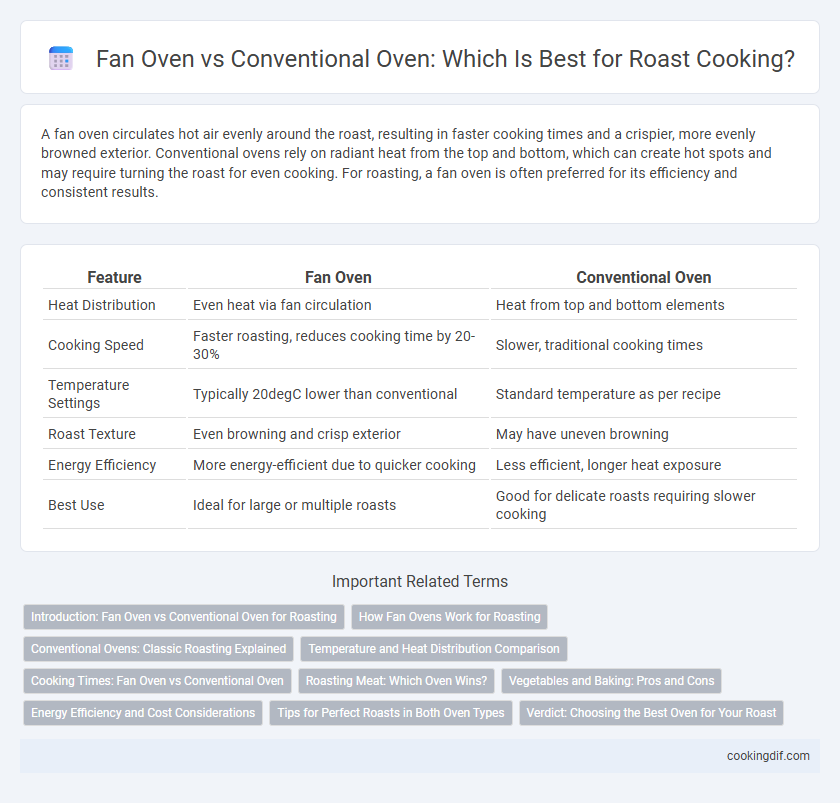A fan oven circulates hot air evenly around the roast, resulting in faster cooking times and a crispier, more evenly browned exterior. Conventional ovens rely on radiant heat from the top and bottom, which can create hot spots and may require turning the roast for even cooking. For roasting, a fan oven is often preferred for its efficiency and consistent results.
Table of Comparison
| Feature | Fan Oven | Conventional Oven |
|---|---|---|
| Heat Distribution | Even heat via fan circulation | Heat from top and bottom elements |
| Cooking Speed | Faster roasting, reduces cooking time by 20-30% | Slower, traditional cooking times |
| Temperature Settings | Typically 20degC lower than conventional | Standard temperature as per recipe |
| Roast Texture | Even browning and crisp exterior | May have uneven browning |
| Energy Efficiency | More energy-efficient due to quicker cooking | Less efficient, longer heat exposure |
| Best Use | Ideal for large or multiple roasts | Good for delicate roasts requiring slower cooking |
Introduction: Fan Oven vs Conventional Oven for Roasting
Fan ovens circulate hot air evenly around the food, resulting in faster and more consistent roasting compared to conventional ovens, which rely on radiant heat from the top and bottom elements. This even heat distribution in fan ovens helps achieve a crispier roast exterior while maintaining juicy interiors, ideal for meats and vegetables. Conventional ovens may require longer cooking times and frequent turning to avoid uneven browning, making fan ovens a preferred choice for efficient and uniform roast cooking.
How Fan Ovens Work for Roasting
Fan ovens use a built-in fan to circulate hot air evenly around the roast, promoting faster and more uniform cooking compared to conventional ovens. This constant airflow helps to create a crispy outer layer while retaining moisture inside the meat, enhancing flavor and texture. The even heat distribution reduces hot spots, ensuring the roast cooks thoroughly and efficiently at slightly lower temperatures.
Conventional Ovens: Classic Roasting Explained
Conventional ovens use radiant heat from the top and bottom elements, creating an even cooking environment ideal for traditional roasting techniques. This method allows meat and vegetables to develop a crispy exterior and tender interior, enhancing flavor through slow, consistent heat. Conventional ovens are preferred for classic roasts like beef, pork, and poultry due to their reliable temperature control and ability to produce a perfectly browned crust.
Temperature and Heat Distribution Comparison
Fan ovens utilize a convection fan to circulate hot air evenly, resulting in consistent heat distribution and typically allowing for roasting at temperatures 20degC lower than conventional ovens. Conventional ovens rely on static heat from the top and bottom elements, which can create hot and cold spots, requiring higher temperatures and more careful monitoring to achieve even roasting. This difference in heat distribution impacts cooking efficiency, with fan ovens offering faster, more uniform roasting and conventional ovens sometimes producing unevenly cooked roasts.
Cooking Times: Fan Oven vs Conventional Oven
Fan ovens typically reduce cooking times by about 25% compared to conventional ovens due to the even heat distribution created by the internal fan, which circulates hot air efficiently around the roast. Conventional ovens rely on radiant heat from the walls, often resulting in longer and less consistent cooking times. For roasting, adjusting the temperature down by 20degC in a fan oven can also help maintain juiciness while achieving faster, more uniform cooking.
Roasting Meat: Which Oven Wins?
Fan ovens circulate hot air evenly around the roasting meat, resulting in faster cooking times and a crispier, well-browned exterior while maintaining juicy interiors. Conventional ovens cook with static heat, which may cause uneven cooking and require longer roasting periods, often leading to less consistent meat texture. For roasting meats, fan ovens typically deliver superior results with more uniform heat distribution and better moisture retention.
Vegetables and Baking: Pros and Cons
Fan ovens circulate hot air evenly, resulting in faster and more consistent roasting of vegetables, producing crisp exteriors and tender interiors with less oil. Conventional ovens provide a gentler heat ideal for slow baking and roasting, preserving moisture in denser vegetables but often leading to uneven browning. Fan ovens may dry out delicate baked goods, whereas conventional ovens excel at maintaining texture in cakes and breads due to their stable heat distribution.
Energy Efficiency and Cost Considerations
Fan ovens distribute heat evenly using a built-in fan, reducing cooking times by up to 30% and lowering energy consumption compared to conventional ovens. Conventional ovens rely on radiant heat, which often requires longer cooking durations and higher energy use, increasing operational costs. Choosing a fan oven for roasting can result in significant energy savings and reduced utility bills over time due to its efficient heat circulation and faster cooking cycles.
Tips for Perfect Roasts in Both Oven Types
For perfect roasts, fan ovens offer even heat circulation, reducing cooking time and ensuring uniform browning, ideal for large cuts like whole chickens or beef joints. Conventional ovens provide dry, radiant heat best suited for slower cooking, which enhances flavor and tenderness in tougher meats such as pork shoulders or leg of lamb. Use a meat thermometer to monitor internal temperature, and allow resting time after roasting to retain juices regardless of oven type.
Verdict: Choosing the Best Oven for Your Roast
Fan ovens provide consistent heat distribution through a circulating fan, resulting in evenly cooked roasts with crispy exteriors and juicy interiors. Conventional ovens rely on radiant heat from top and bottom elements, creating a slower, more traditional cooking process that may require turning or rotating the roast for uniformity. For optimal roast results, fan ovens deliver efficiency and precision, while conventional ovens suit those who prefer classic cooking methods and slower heat application.
Fan Oven vs Conventional Oven for roast cooking Infographic

 cookingdif.com
cookingdif.com